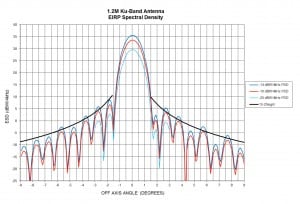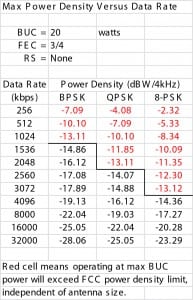Power Spectral Density – More is not Necessarily Better (Part 2)
As mentioned in last month’s part one of this article, power density is the single most important operating parameter for transmitting earth stations and probably the least understood. A terminal operator that does not keep his power density within strict limits could become a problem interferer and lose his license to transmit. Last month we focused on what power density is and the critical role it plays in the design of today’s satellite communication systems and limiting the amount of interference every satellite terminal experiences during normal operation. In this second and final part, we will describe how this parameter is used to enable use of small or disadvantaged terminals, how easy it is to configure a typical terminal to exceed the limit and cause trouble, and what we as an industry should consider doing to improve the situation. Performance Considerations
Starting in 2004, the Federal Communications Commission (FCC) changed its regulations on satellite earth stations to include power density limits in what had been primarily antenna pattern requirements. Along with the maximum power density requirement of -14 dBW/4kHz, an off-axis EIRP envelope was added that is defined by the equation 15 – 25 log dBW/4kHz. The new off-axis ESD equation is the result of combining the maximum power density requirement (-14 dBW/4kHz) with the original antenna off-axis antenna gain envelope (29 – 25 log dBi). Th is new curve could be viewed as a redundant requirement, but the FCC is using this curve to provide earth station applicants with greater flexibility in the design and operation of their terminals. It is now possible to obtain FCC approval for a terminal with an antenna that is not fully compliant with the off-axis antenna gain envelope, provided it is operated in such a way that the off-axis EIRP envelope is not exceeded. This is done by accepting a stricter (lower) limit on maximum power density that compensates for the antenna’s non-compliance. This type of license is not unusual for terminals with especially small apertures and those employing axis-symmetric antennas that typically have higher sidelobes due to aperture blockage. This terminal performance trade-off is illustrated in Figure 4. In this way, a less expensive or more compact terminal can be made available to users when maximum power density is not necessary. Terminal designers and operators should keep in mind that the inverse is also true. If your terminal antenna performs better than the FCC specifies for off-axis gain, such as in the case of terminals employing a well designed and manufactured offset reflector antenna, then the maximum allowed power density for that terminal can be increased above the standard limit by a corresponding amount creating a significant performance advantage over other systems of the same size and power. The emphasis on power density in the earth station licensing is well placed. Exceeding this limit hurts your satellite network and those of your neighbors in many ways. It even has the potential to degrade the performance of your communications channel. More is not always better when discussing power density. As should be apparent from the previous discussion, exceeding the maximum allowed power density will result in excessive interference to users on neighboring satellites utilizing the same spectrum. What may not be as obvious is the effect this noncompliant behavior has on other users on the same satellite. Your signal’s energy is not completely contained within your assigned communications channel. Some of that energy spills over into adjacent channels, interfering with other users. Also, the polarization of the signal your terminal transmits (i.e. Linear Horizontal or Right-Hand Circular) is not perfect and some of your signal’s energy is picked up by the satellite on the orthogonal polarization. Users on that “cross-polarized” channel suffer as a result. These degradations are factored into the design of all satellite links, but it all works only if substantially all terminals operate within their authorized power density limits. Finally, how a satellite transponder operates needs to be considered. This is where adding too much power to your signal can degrade your own service. The transponder on the satellite converts and adds significant power to all the user signals it receives. Since resources (size, weight and especially power) on the satellite are extremely precious, the high-power amplifier in each transponder must operate very close to an optimal output power point. Running at lower output power wastes satellite power. Running at higher output power levels induces non-linear behavior that degrades (adds noise to) every communications signal passing through the transponder. Any potential advantage a terminal gains by exceeding its power density requirement is quickly lost due to these non-linear effects. In addition, every other user on that transponder will also suffer some performance degradation. How hard is it to exceed your power density limit with today’s terminals? It is much easier than many people realize. Consider a 1.2-meter Ku-band terminal designed primarily to provide a medium-availability, medium data rate uplink to support damage assessment teams after a disaster. This terminal will see secondary use in disaster relief missions, providing Internet connectivity in areas that have lost those services. Please see Table 1 for a range of maximum power density values that this terminal can generate assuming various data rates and modulation types. The table is color coded to show how the maximum power density at each operating point compares to the FCC’s maximum allowance. It should be clear that this terminal configuration, which is pretty typical for a transportable VSAT terminal, is a “loaded gun” when it comes to firing off signals that exceed the specified limit and could cause significant interference issues. Room for Improvement
Given the important role power density plays in keeping interference between terminals at acceptable levels, it is surprising to see how infrequently it is mentioned on satellite terminal data sheets and in marketing literature. While the maximum allowable EIRP (density) detailed on relevant type approval documents may be included, what that limit means in practical terms is usually missing. Other simpler one-dimensional capabilities like maximum EIRP and the saturated output power of the HPA/BUC are emphasized. This is what customers are used to seeing with regards to the transmit capability for a given terminal and using as the basis for their buying decision. They may not appreciate the fact that they are actually buying more capability than they need and increasing the probability that they will inadvertently transmit a signal in excess of the power density limit at some point in time. As with the document that sets the maximum allowable EIRP density, the terminal data sheet should include a table detailing maximum allowable HPA/BUC power levels for typical data rates and modulation types that might apply to that particular terminal. That table could be passed along to the operator of the terminal to assist in setting guidelines that will keep the terminal within specified operating limits. Even better would be monitor and control software in every terminal that ensures the terminal operates within specified power density limits. As mentioned by many others, the Global VSAT Forum in particular, our satellite industry could benefit greatly from improvements in the training of satellite terminal installers and operators on this topic and many others. Increased awareness in all facets of our business is necessary to make material progress toward optimally managing our satellite communications resources and minimizing the waste that results when we allow interference to take its toll. With proper safeguards in place, the following real-world scenario will hopefully never be repeated: An authorized terminal was deployed and successfully brought into service. Unknown to all involved, the terminal was peaked quite well, but on the wrong satellite, a close neighbor of the correct satellite. Antenna peaking was accomplished using a broadband power detector and the higher power neighboring satellite made the correct satellite hard to detect. The antenna was relatively small, with a beam broad enough to receive a marginally acceptable signal from the correct satellite when mis-pointed by this amount. The terminal had more than enough transmit power to close this particular uplink under nominal conditions and, unfortunately, just enough to close the link under this extreme condition. The terminal was now operating more like a jammer of the neighbor satellite than another interfering terminal. It took many hours of intense cooperation between satellite operators to identify the offending terminal and correct the situation. In the meantime, a popular broadcast was taken off the air and the reputations of a major content delivery and satellite operating company were damaged. Had the operator of the above terminal realized what HPA/BUC power level corresponded to the maximum allowable power density for that particular satellite link, he would have realized that something was drastically wrong long before he turned his terminal into an unintentional jammer. Absolutely no one should be surprised by the potential for trouble when the fundamental piece of information communicated in a terminal’s license is not well understood by the person entrusted to make sure the equipment operates in compliance with that critical requirement. The best approach going forward might be incorporating power density into the Monitor and Control (M&C) software running on most modern terminals and using that information locally, and remotely at the Network Operations Center, to ensure the terminal is configured correctly and operating nominally. At a minimum, the terminal operator needs to appreciate the importance of power density and have easy access to a table (or App) that allows him to quickly determine his power density and compare it to what it should be at that moment and the value he cannot exceed. With better tools and training, terminal operators will become more power density conscious and the entire satellite communications industry will benefit as a result. VS

